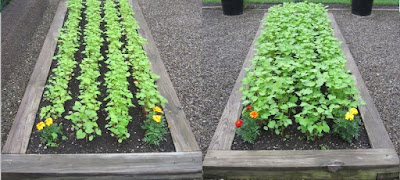Every spring is a blank slate for a garden. You aren't sure what sort of challenges you will face this year. When will the last frost be? Will it be a hot summer? A wet one? A short one? Will the cucumber beetles be bad or non-existent? Will blight drift in on the wind from an unknown source? All of these things would be really good to know up front, but all you can do is plan. And as they say "Man plans. God Laughs". Still, you do your best. And your best does not mean you walk out into the garden with a packet of seeds and go "Eeny Meeny Miny Moe..." You must know your garden and if you know your garden you know what will grow best where.
 |
| The Garden in April |
This post is specifically about crop rotation. This question was brought up in the comments from my last post and I found I had such extensive thoughts on the subject that I couldn't answer the question with a few short sentences. I have different views of the importance of rotation now than when I started out. The basic theory is this: you should group your crops into four different types based on growing conditions and requirements and then rotate your planting locations so that each type is in the same place no less than four years apart.
 |
| Source |
Crop rotation should be done for two reasons. #1 pest/disease control and #2 nutrient depletion. Raised Beds are a different scenario than field crops or even traditional in the ground tilled row garden which may easily vary in size or location from year to year. I used to garden in a wide open plot. I outlined the steps we took that brought us to our raised beds in this post. When you switch to raised beds you impose certain limitations of scale on your garden. Some of these can be manipulated in the construction phase and I'm sure all of us would layout our second gardens differently than our first one.
 |
| A Traditional American backyard row garden |
Part of the issue is that you don't necessarily grow the same amount of each type of crop. And those amounts may vary from year to year. You may not grow any root crops at all. Or you may have found that root crops do better in containers. You may grow some lettuce and cabbages, but not in the same quantities as beans and peas. Suddenly having four rotating groups fails to apply to your garden.
 |
| When you utilize containers you effectively remove that crop from rotation |
 |
| Not everyone needs a whole bed of lettuce. I plant lettuce alongside my peas even though they are in different groups. |
When you are working with permanent raised beds if you have a pest or disease problem in one bed you're going to have that pest in all your beds because they are so close together. Unless it's appears to be more of a fungal type soil problem specific to that bed. In the case of fungal soil problems (or a weed problem) I will occasionally rest a bed and try solarization. But you are really better off just replacing or diluting that soil with fresh soil and being done with it. This is possible in raised beds but nearly impossible on a larger scale with field crops.
 |
| Soil solarization is a non-chemical method for controlling soilborne pests using high temperatures produced by capturing radiant energy from the sun. |
 |
| We used to cover the beds with road fabric and only uncover the beds we were planning to use, resting the others while controlling weeds and pests. |
 |
| My Organic Fertilizer Stash |
Because beds can only take so much new compost, I turn to more concentrated sources adding blood meal, bone meal, potash, worm castings and biochar every year before I plant and then follow up with additional slow release Garden-tone throughout the season. When choosing blood meal(N), bone meal(P) or potash(K) over a balanced fertilizer, you should follow the N-P-K guidelines for your intended crop.
 |
| Blood meal was added to the right side for cucumbers. The bean plants closer to the right show greener foliage than those on the left edge. |
 |
| Beds prepared the same and seeds planted on the same day |
Another rotation consideration is to try to find a bed that they do better in because of sun, wind and water patterns. The differences are subtle but consistent and each of my four corner beds have a prevailing issue related to one of those. The eight beds in the middle are much more reliable.
 |
| The prevailing growing conditions in my garden layout |
Ahhhh . . . makes sense to me! Thanks!
ReplyDelete--Melanie